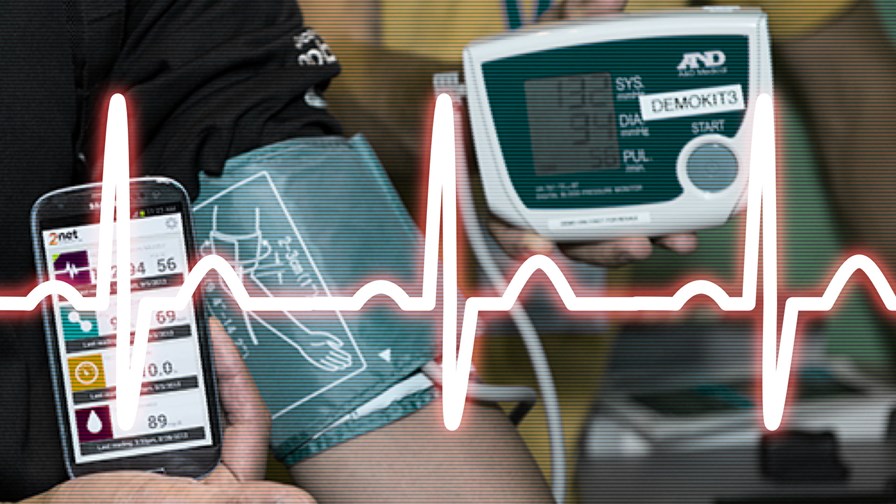
© Qualcomm / TTV montage
- Qualcomm divests its health and EV charging businesses
- Life and Halo divisions sneak out the back door
- Medical products already in use in 40 countries
- Market for EV charging expected to be $50bn in 2030
Well that was a little sneaky; selling off two of your business units without making an official statement. Last week, Qualcomm sold its Qualcomm Life healthcare technology and its Qualcomm Halo electric vehicle charging businesses to a private equity firm and wireless company respectively. It was left to the buyers to announce the deals, though no financial details were provided.
The withdrawal from these two associated markets is further evidence that Qualcomm is refocusing on its core activities. It comes as the company continues its seemingly never-ending war of attrition in courts across the globe surrounding claims and counter-claims over various IPR and business practices. These are extremely well documented elsewhere (here is probably the best place for detailed information). It is still counting the cost of its failed plan to buy NXP, having ended its attempts to acquire NXP last year and waved goodbye to Paul Jacobs and his allies. Now it is facing the prospect that its dominance over cellular modem IPR may be further challenged as reports claim Apple is setting up shop in Qualcomm’s backyard of San Diego to design its own 5G modems.
Corporate health
TelecomTV’s Tracker service identified 97 telecoms-related press releases from Qualcomm in the past year. The vast majority were 5G or devices related, but Qualcomm Life and Qualcomm Halo didn’t really get a look in.
Qualcomm’s last major Life announcement was in November last year, covering new capabilities to simplify clinical workflows and create data-driven insights. But to be honest, peak activity seemed to be around 2012 and 2013. The company announced the wholly-owned subsidiary Qualcomm Life in December 2011, which brought together its existing Wireless Health business and a new $100 million Qualcomm Life Fund investment allocation. Its first products were the 2net Platform and Hub to connect wireless medical devices with cloud-based data solutions.
“Qualcomm Life was founded, in part, to assist medical device manufacturers who approached Qualcomm for help when their own wireless connectivity attempts became untenable due to technology selection errors, unscalable deployment models and prohibitively high operational support costs,” explained Rick Valencia, VP and GM of Qualcomm Life at the time.
Fast-forward to today, and the news that the business has been acquired by US private equity firm Francisco Partners and rebranded as Capsule Technologies, or CapsuleTech for short.
“Francisco Partners’ acquisition will help Qualcomm Life (now CapsuleTech) continue to deliver market leading products and services to its world class customer base,” said Valencia, who will support CapsuleTech as an advisor in its transition to a standalone company. It will operate with two distinct business segments: Capsule will provide medical device connectivity solutions for hospitals; and 2net will continue as a medical-grade mobile connectivity platform.
Does this mean Qualcomm’s foray into connected healthcare was a failure, or that the whole healthcare IoT market is not as lucrative and appealing as once thought? Difficult to say, as Qualcomm never broke out the relevant segmented financials in its reporting. However, the new Capsule owners say it remains “a leading medical device connectivity platform that connects medical devices to clinical information systems in over 2,000 hospitals in approximately 40 countries”. Perhaps all that was really needed was a more focused structure and support, which might still have been possible if Qualcomm had made different strategic decisions over the past few years.
Wireless charging
All of which brings us to Qualcomm’s other moonshot technology – electric vehicle (EV) wireless charging. On the same day it disposed of Qualcomm Life, the company also signed a deal with US-based WiTricity to sell “certain technology platform and IP assets” from its Halo wireless charging business. WiTricity says it will now own over 1,500 patents or patent applications related to wireless charging. Qualcomm will become a minority WiTricity shareholder as part of the transfer.
WiTricity Corporation was founded in 2007 to commercialise technology for wireless electricity transfer, using magnetic resonance, developed by a team of physicists from MIT led by Professor Marin Soljačić. It is already demonstrating solutions for EV charging with carmakers that include BMW, Honda and Toyota. The company estimates more than 120 million EVs will be on the road by 2030 with over $50 billion being invested in charging infrastructure.
Qualcomm set up its EV division at the back end of 2011 when it acquired HaloIPT, having been investing in wireless power technology for a number of years, building a team in the UK as part of the Qualcomm European Innovation Development group. Halo was a result of some 20 years of wireless power research work at the University of Auckland in New Zealand. Two days after the formation of the new division, Qualcomm announced its contribution to the first EV wireless charging trial in London, backed by the UK Government.
“WiTricity’s wireless charging technology is key to the future of mobility which is clearly electric, and increasingly shared and autonomous.” said Alex Gruzen, CEO of WiTricity. “Bringing the Qualcomm Halo technology into the WiTricity portfolio will simplify global interoperability and significantly accelerate commercialisation.”
Qualcomm’s expanded interest in non-core wireless sectors was overseen during Matt Grob tenure at the company. Grob became CTO in July 2012 after a stint as SVP of Corporate R&D. His stated objective at the time was to expand the company’s reach beyond wireless connectivity into “exciting new areas such as augmented reality, wireless charging, processor and applications enhancements and peer-to-peer technologies”. Grob left in May 2018 to follow Paul Jacobs and Derek Aberle to create XCom, which is currently either in stealth mode or doing nothing, depending on how generous you interpret an absence of information.
Email Newsletters
Sign up to receive TelecomTV's top news and videos, plus exclusive subscriber-only content direct to your inbox.




